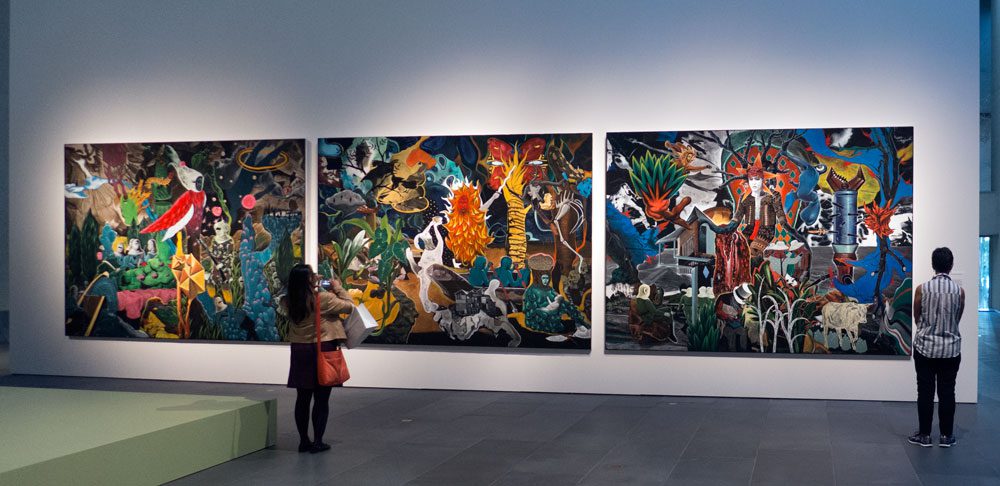When I stumbled across Rodel Tapaya’s solo exhibition at the National Gallery of Australia, the installations and paintings showcasing his multiple talents immediately caught my attention. The two rooms offer a thoughtful and impressive treatise on the social and historical complexities of Tapaya’s native Philippines, as well as their reverberations on contemporary life. Tapaya weaves specific folkloric tales into his art, but the strength of the sculpture installations in particular derives from their ability to speak to a wider audience. In much of Tapaya’s work, his scenes show how larger phenomena coalesce to inform interpersonal and individual experiences.
For example, the installation Modern Manananggals (2013) is a powerful indictment of the social conditions and poverty that propel millions of Filipinos to other countries in search of work. Disembodied angels carrying suitcases hang eerily from the ceiling, while their lower halves are firmly planted on the floor. The unresolved visual juxtaposition suggests to the viewer the tensions experienced by economic migrants, whose displacement from their homes and families transform them into beings neither dead nor living. I found this piece incredibly powerful, and only wish that audiences could meander through the installation to see the details up close, instead of peering in, from behind a rail.
Of Tapaya’s paintings, I found My Way (2016) to be the most intriguing. The loose brushstrokes used to depict the human body in rapid motion is strikingly reminiscent of Francis Bacon’s boxing scenes, yet the scene is very much Tapaya’s. The piece captures the incidents of violence that occurred in karaoke bars with Frank Sinatra’s song, ‘My Way’. In My Way, the viewer cannot help but think Tapaya is trying to make a point about masculinity, the human predilection for violence, and especially now, how President Rodrigo Duterte has successfully appealed to vigilante justice in his bloody, war on drugs.
Another set of paintings, the triptych The promise land: the moon, the sun, the stars (2016), stretches 10 metres across and commands the viewer’s attention right at the start of the exhibit. Yet while NGA’s Senior Curator Jaklyn Babington draws comparisons with the Mexican muralists and Frida Kahlo, I found Hieronymous Bosch to be a more apt comparison. While Mexican muralists such as Diego Rivera often worked to propel their own political agendas through art, Tapaya captures scenes that provoke the audience to reflect and think critically. In addition, the fantastical nature of Tapaya’s triptych is more semblant of Bosch’s nightmarish creatures in The Garden of Earthly Delights than the Mexican muralists’ primary focus on figurative representation.
While the scale of the work is indeed impressive, I could not help but think that Tapaya was overly ambitious in this NGA-commissioned piece. There is no doubt concerning Tapaya’s skills, but with every nook and cranny filled with coded imagery and symbolism, the omission of negative space creates a more collaged thicket of images rather than a sweeping visual narrative. In the work of Bosch and the Mexican muralists’ work – whether it be in José Clemente Orozco, David Rivera or David Alfaro Siqueiros’ murals, and even in Frida Kahlo’s surrealism – there is a strategic use of negative space that is not present in Tapaya’s overcrowded triptych. In contrast, most of Tapaya’s smaller works employ a more liberal use of space that allows for greater dynamism between characters.
As Tapaya’s work continues to evolve, I’ll be keenly following his artistic trajectory as well as his creative social critiques. In the meantime, I can only hope that the NGA will continue to support diverse young artists like Tapaya to enrich the cultural and political perspectives of its visitors.
Rodel Tapaya: New art from the Philippines is on display until August 20, 2017. Entry is free.
We acknowledge the Ngunnawal and Ngambri people, who are the Traditional Custodians of the land on which Woroni, Woroni Radio and Woroni TV are created, edited, published, printed and distributed. We pay our respects to Elders past and present. We acknowledge that the name Woroni was taken from the Wadi Wadi Nation without permission, and we are striving to do better for future reconciliation.
